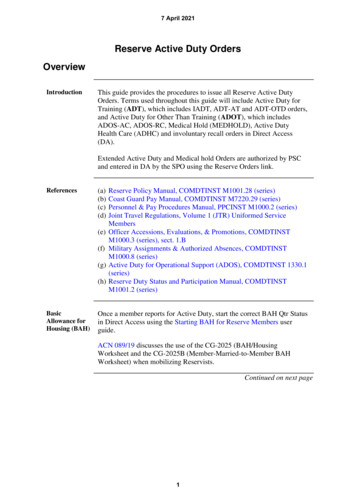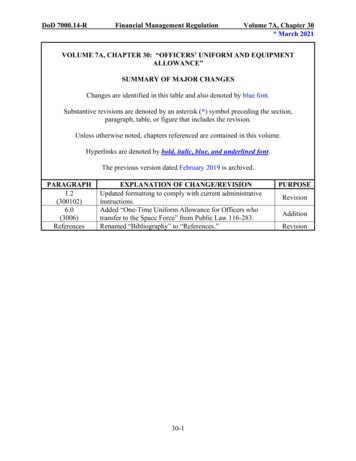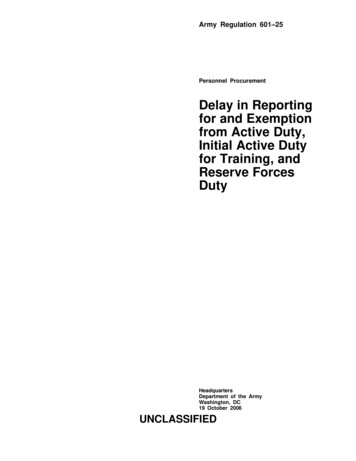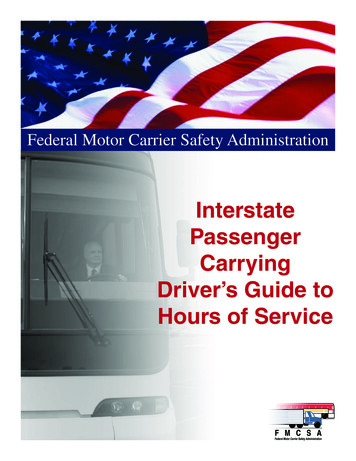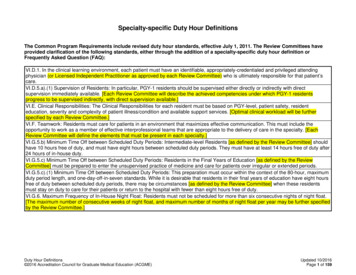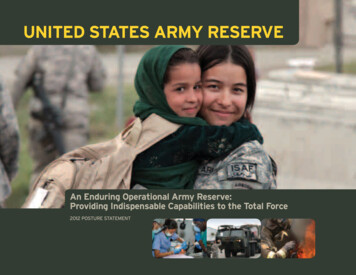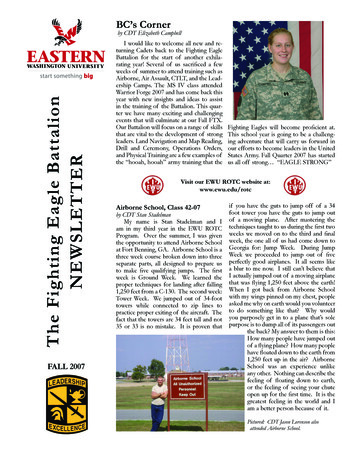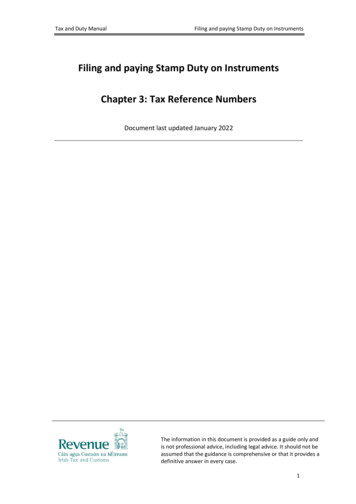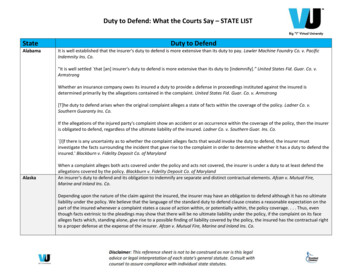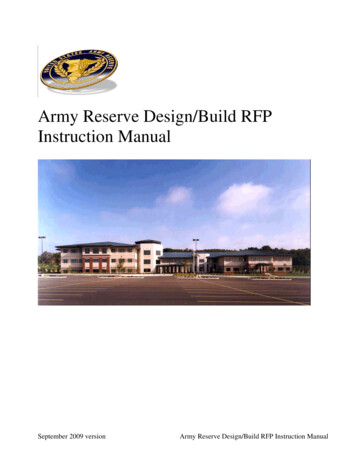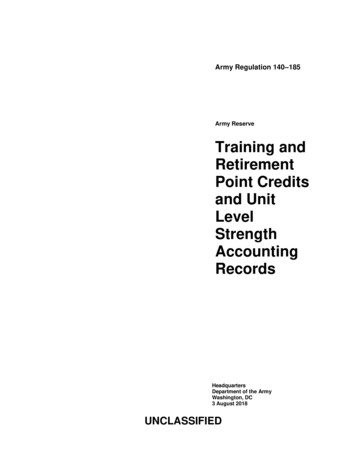
Transcription
Reserve Duty Status andParticipation ManualCOMDTINST M1001.2February 2021
ON THE COVER: A Coast Guard Port Security Unit 311 boat crew conducts tactical boat crewtraining during a pre-deployment exercise in the Port of Los Angeles, Calif. The TransportablePort Security Boat is a 32-foot platform offering ballistic protection and more versatility fordeployment.
CommandantUnited States Coast GuardUS Coast Guard Stop 77212703 Martin Luther King JR Ave SEWashington, DC 20593-7721Staff Symbol: CG-RPhone: (202) 475-5039Fax: (202) 475-5431COMDTINST M1001.205 FEB 2021COMMANDANT INSTRUCTION M1001.2Subj:RESERVE DUTY STATUS AND PARTICIPATION MANUALRef:(a) Title 10, United States Code(b) Full-Time Support (FTS) to the Coast Guard Reserve Component, COMDTINST5320.3 (series)(c) Reserve Force Readiness System (RFRS) Staff Element Responsibilities,COMDTINST 5320.4 (series)(d) Title 14, United States Code(e) Uniform Reserve, Training, and Retirement Categories for the Reserve Components,DoDI 1215.06(f) Reserve Components Common Personnel Data System (RCCPDS), DoDI 7730.54(g) Administration and Management of the Individual Ready Reserve (IRR) and theInactive National Guard (ING), DoDI 1235.13(h) Military Separations, COMDTINST M1000.4 (series)(i) Management of the Standby Reserve, DoDI 1235.09(j) Screening the Ready Reserve, DoDD 1200.7(k) Ready Reserve Member Participation Policy, DoDI 1215.13(l) Coast Guard Weight and Body Fat Standards Program Manual, COMDTINSTM1020.8 (series)(m) Military Assignments and Authorized Absences, COMDTINST M1000.8 (series)(n) Service Credit for Non-Regular Retirement, DoDI 1215.07(o) Personnel and Pay Procedures Manual, PPCINST M1000.2 (series)(p) DoDI 7000.14-R Financial Management Regulation, Volume 7A Chapter 10(q) Title 37, United States CodeDISTRIBUTION – SDL No. 170aABCDEFGHbcdefghX X X X X X X XX X X X X X XX XX XXX XX XX XXXXXNON-STANDARD DISTRIBUTION:ijklmnopqrstuX XX X X X X XXXX XX X XX X X XXXX XX XX XXX XXXX XvwxyzX X X XX X XX X X
COMDTINST M1001.2(r) Coast Guard Medical Manual, COMDTINST M6000.1 (series)(s) Coast Guard Health Promotion Manual, COMDTINST M6200.1 (series)(t) Joint Travel Regulations (JTR)(u) Coast Guard Pay Manual, COMDTINST M7220.29 (series)(v) Officer Accessions, Evaluations, and Promotions, COMDTINST M1000.3 (series)(w) Enlistments, Evaluations, and Advancements, COMDTINST M1000.2 (series)(x) Coast Guard Special Needs Program, COMDTINST 1754.7 (series)(y) Coast Guard Recruiting Manual, COMDTINST M1100.2 (series)(z) Active Duty for Operational Support (ADOS), COMDTINST 1330.1 (series)(aa) Accessing the Reserve Components (RC), DoDI 1235.12(bb) Military Justice Manual, COMDTINST M5810.1 (series)(cc) Coast Guard Supplement to the Joint Travel Regulations (CGS-JTR),COMDTINST M4600.17 (series)(dd) Performance, Training and Education Manual, COMDTINST M1500.10 (series)(ee) Uniform Regulations, COMDTINST M1020.6 (series)(ff) Family Care Plans, DoDI 1342.19(gg) DoD Yellow Ribbon Reintegration Program (YRRP), DoDI 1342.28(hh) Medals and Awards Manual, COMDTINST M1650.25 (series)(ii) Uniformed Services Employment and Reemployment Rights Act (USERRA),Chapter 43 of 38 United States Code(jj) Military Civil & Dependent Affairs Manual, COMDTINST M1700.1 (series)(kk) Montgomery GI Bill–Selected Reserve Educational Assistance Program,COMDTINST 1001.30 (series)(ll) Montgomery GI Bill–Selected Reserve (MGIB-SR), DoDI 1322.17(mm) Pregnancy in the Coast Guard, COMDTINST 1000.9 (series)(nn) Discipline and Conduct, COMDTINST M1600.2 (series)1. PURPOSE. This Manual describes policies and procedures governing the duty statuses,component categories, and the participation standards of the Coast Guard Reserve.2. ACTION. All Coast Guard unit commanders, commanding officers, officers-in-charge,deputy/assistant commandants, and chiefs of headquarters staff elements must comply with theprovisions of this Manual. Internet release is authorized.3. DIRECTIVE AFFECTED. The Reserve Policy Manual, COMDTINST M1001.28 (series)Chapters 1, 2, 3, and 4.4. DISCLAIMER. This guidance is not a substitute for applicable legal requirements, nor is ititself a rule. It is intended to provide operational guidance for Coast Guard personnel and isnot intended to nor does it impose legally-binding requirements on any party outside theCoast Guard.2
COMDTINST M1001.25. ENVIRONMENTAL ASPECT AND IMPACT CONSIDERATIONS.a. The development of this Manual and the general policies contained within it have beenthoroughly reviewed by the originating office in conjunction with the Office ofEnvironmental Management, Commandant (CG-47). This Manual is categoricallyexcluded under current Department of Homeland Security (DHS) categorical exclusionDHS (CATEX) A3 from further environmental analysis in accordance with the U.S.Coast Guard Environmental Planning Policy, COMDTINST 5090.1 and theEnvironmental Planning (EP) Implementing Procedures (IP).b. This Manual will not have any of the following: significant cumulative impacts on the humanenvironment; substantial controversy or substantial change to existing environmentalconditions; or inconsistencies with any Federal, State, or local laws or administrativedeterminations relating to the environment. All future specific actions resulting from thegeneral policy in this Manual must be individually evaluated for compliance with theNational Environmental Policy Act (NEPA) and Environmental Effects Abroad of MajorFederal Actions, Executive Order 12114, Department of Homeland Security (DHS) NEPApolicy, Coast Guard Environmental Planning policy, and compliance with all otherapplicable environmental mandates.6. DISTRIBUTION. No paper distribution will be made of this Manual. An electronic version willbe located on the following Commandant (CG-612) web sites: Internet at:https://www.dcms.uscg.mil/directives and ives/SitePages/Home.aspx.7. RECORDS MANAGEMENT CONSIDERATIONS. This Manual has been evaluated forpotential records management impacts. The development of this Manual has been thoroughlyreviewed during the directives clearance process, and it has been determined there are no furtherrecords scheduling requirements, in accordance with Federal Records Act, 44 U.S.C. 3101 etseq., National Archives and Records Administration (NARA) requirements, and the Informationand Life Cycle Management Manual, COMDTINST M5212.12 (series). This policy does notcreate significant or substantial change to existing records management requirements.8. FORMS/REPORTS. The forms referenced in this Manual are available in USCG. ElectronicForms on the Standard Workstation or on the Internet: on-ManagementCG-61/Forms-Management/; SitePages/Home.aspx .9. REQUESTS FOR CHANGES. Units and individuals may recommend changes by writing viathe chain of command to: Commandant (CG-R), 2703 Martin Luther King Jr. Ave SE STOP7721, Washington, DC 20593-7721./T. C. WIEMERS/Rear Admiral, U.S. Coast GuardAssistant Commandant for Reserve3
COMDTINST M1001.2RECORD OF CHANGESCHANGE NUMBERDATE OF CHANGEDATE ENTERDiENTERED BY
COMDTINST M1001.2TABLE OF CONTENTSCHAPTER 1 THE COAST GUARD RESERVE . 1-1A. Reserve Component Overview . 1-1B. Mission Authority and Statutory Basis . 1-1C. Reserve Component Categories (RCC) . 1-21. Ready Reserve (R) . 1-22. Standby Reserve (S). . 1-43. Retired Reserve (V). . 1-64. Retired Reserve Recall and Promotion . 1-7D. Training/Pay Categories (TRAPAY CATS). 1-7E. Authorized Types of Duty . 1-7CHAPTER 2 AUTHORIZED TYPES OF DUTY . 2-1A. Inactive Duty. 2-11. Inactive Duty Overview . 2-12. Inactive Duty Types . 2-23. Inactive Duty Orders . 2-104. Inactive Duty Without Pay. 2-105. Absences . 2-116. Travel While on Inactive Duty . 2-117. Berthing While on Inactive Duty . 2-12B. Active Duty . 2-131. Active Duty Overview . 2-132. Reserve Component Active Duty Utilization Authorities . 2-143. Active Duty Orders . 2-214. Active Duty Without Pay . 2-225. Short-Term and Long-Term Active Duty . 2-226. Travel While on Active Duty Orders . 2-237. Active Duty Order Issuing Authority . 2-248. Members Accumulating Over 14 Years Total Active Duty . 2-279. Members Accumulating Over 16 Years Total Active Duty . 2-2710. Members Accumulating Over 18 Years Total Active Duty . 2-2711. Cancellation or Early Termination of Orders . 2-2712. Resident Training . 2-2813. Resident Training Availability. 2-2914. Course Descriptions and Schedules . 2-29CHAPTER 3 PARTICIPATION STANDARDS . 3-1A. Participation Standards Overview. 3-1B. Participation Standards . 3-11. SELRES Obligations . 3-12. Travel or Change of Residence . 3-5i
COMDTINST M1001.2C.D.E.F.3. IRR Satisfactory Participation . 3-64. Standby Reserve (ASL or ISL) Satisfactory Participation . 3-6Annual Screening Questionnaire . 3-7Unsatisfactory Participation . 3-81. Counseling and Disciplinary Action . 3-82. Compliance Measures . 3-93. Failure to Undergo Physical and Dental Examination . 3-12Employment by a Foreign Government . 3-12Waiver of Benefits . 3-12CHAPTER 4 RETIREMENT CATEGORIES . 4-1A.B.C.D.E.Retirement with Pay (RET-1) . 4-1Retirement Awaiting Pay (RET-2) . 4-2Retirement for Physical Disability (RET-3) . 4-2Retirement for RC Members with 20 Years of Active Duty Service (RET-4) . 4-2Voluntary Separation Incentive (VSI) (RET-5) . 4-3LIST OF TABLESTable 1-1: TRAPAY CATS . 1-8Table 2-1: Reserve Component Active Duty Utilization Authorities . 2-15Table A-1: SELRES TRAPAY CATS . A-1Table A-2: IRR TRAPAY CATS . A-2Table A-3: STANDBY RESERVE TRAPAY CATS . A-3LIST OF FIGURESFigure 1-1: Reserve Component Categories . 1-2Figure 2-1: Inactive Duty Types . 2-2APPENDIX AA1. SELRES Training/Pay Categories (TRAPAY CATS) . A-1A2. IRR Training/Pay Categories (TRAPAY CATS) . A-2A3. Stand By Reserve Training/Pay Categories (TRAPAY CATS) . A-3ii
COMDTINST M1001.2CHAPTER 1. THE COAST GUARD RESERVEA. Reserve Component Overview. The Coast Guard Reserve is a fundamental component of theCoast Guard where mobilization readiness is the primary mission.1. Reservists are members of the Coast Guard Reserve force; they are otherwise civiliansand may have careers outside the military. The Reserve Component (RC) is comprised ofnewly accessed officers, enlisted, and prior active duty members who joined the RCvoluntarily, or affiliated to complete their remaining military service obligation.2. The Commandant’s Reserve Policy Statement identifies the missions supported by theCoast Guard Reserve and is available at: https://www.reserve.uscg.mil.3. The purpose of the Coast Guard Reserve is outlined in Reference (a), Title 10 U.S.C.§10102. When members of the RC are required for contingencies, the Commandant willidentify the appropriate RC authority based on the nature, scope and expected duration ofthe emergency.4. The Reserve Force Readiness System (RFRS) is resourced by Full-Time Support (FTS)military or civilian personnel funded by the Reserve, within the Operations and Support(O&S) – Military Personnel Support appropriation. FTS staffs are the subject matterexperts for processes and procedures regarding members of the RC as outlined inReference (b) Full-Time Support (FTS) to the Coast Guard Reserve Component,COMDTINST 5320.3 (series) and Reference (c) Reserve Force Readiness System(RFRS) Staff Element Responsibilities, COMDTINST 5320.4 (series). FTS staff musteffectively develop, train, instruct, and administer the RC on a daily basis in theexecution of operational missions and readiness, in accordance with Reference (a), Title10 U.S.C. §12501.5. Reserve Component Managers (RCM) are Reserve officers on active duty who organize,administer, recruit, instruct, or train members of the RC, in accordance with Reference(a), Title 10 U.S.C. §12310. RCMs are included in the FTS numbers provided for the RCand do not count against the Coast Guard Active Component (AC) end-strength.B. Mission Authority and Statutory Basis. The Coast Guard draws status and mission authorityfrom Titles 10 and 14 of the United States Code (U.S.C.):1. Reference (a), Title 10 U.S.C. §10101. Identifies the Coast Guard Reserve as one of theseven Reserve components of the Armed Forces.2. Reference (a), Title 10 U.S.C. §10102. States the “purpose of each Reserve component isto provide trained units and qualified persons available for active duty in the armedforces, in time of war or national emergency, and at such other times as the nationalsecurity may require, to fill the needs of the armed forces whenever more units andpersons are needed than are in the Regular components.”1-1
COMDTINST M1001.23. Reference (d), Title 14 U.S.C. §309. Describes the Director of the Coast Guard Reserveas the principal advisor to the Commandant on Coast Guard Reserve matters and mayhave such additional functions as the Commandant may direct.4. Reference (d), Title 14 U.S.C. §3701. Provides the basic operating authority for theCoast Guard Reserve, under the direction of the Commandant.5. Reference (d), Title 14 U.S.C. §3704. Specifically confers upon any member of theCoast Guard Reserve serving on active duty or inactive-duty training “the same authority,rights, and privileges in the performance of that duty as a member of the Regular CoastGuard of corresponding grade or rating.”C. Reserve Component Categories (RCC). Members of the RC not counted in AC end-strengthsmust be placed in an RCC and a Training/Pay Category (TRAPAY CAT) as outlined furtherin Appendix A, based on their obligations, in accordance with Reference (e), UniformReserve, Training, and Retirement Categories for the Reserve Components, DoDI 1215.06and Reference (f), Reserve Components Common Personnel Data System (RCCPDS), DoDI7730.54. There are three RCCs: the Ready Reserve (R), the Standby Reserve (S), and theRetired Reserve (V), as illustrated in Figure 1-1Figure 1-1: Reserve Component Categories1. Ready Reserve (R). All members of the Ready Reserve are in an active status, and aresubject to immediate recall to active duty. The Ready Reserve consists of the following:a. Selected Reserve (SELRES). Consists of members within the Ready Reservedesignated as essential to contingency requirements and have priority over all otherReserve elements.1-2
COMDTINST M1001.2(1) These members are assigned to a position on the Personnel Allowance List (PAL)at Coast Guard or selected Joint Service units. SELRES members are required totrain for mobilization by participating in Inactive Duty Training (IDT) and ActiveDuty for Training (ADT) periods for the purpose of Annual Training (AT), inaccordance with Reference (a), Title 10 U.S.C. §10147 and Reference (e),Uniform Reserve, Training, and Retirement Categories for the ReserveComponents, DoDI 1215.06. Coast Guard SELRES members are generallyauthorized 48 paid IDT drills and 12 paid ADT days per fiscal year. See Chapter2, Section A of this Manual for policy regarding inactive duty types. Additionaldrills or training duty may be authorized by the Office of Reserve Resources,Readiness, and Analysis (CG-R8) based on the needs of the Service andavailability of RT funding.(2) All members appointed, enlisted, or transferred into the SELRES must agree toserve for a specified period, and under no circumstances must that service be for aperiod of less than one year. The specified period must be agreed to by executionof an enlistment/commission contract outlining SELRES obligation, or anAdministrative Remarks, Form CG-3307, entry.b. Individual Ready Reserve (IRR). Consists of trained members that previously servedin the active forces or in the SELRES. The IRR consists of members of the RC whomust fulfill their military service obligation, and those who have fulfilled theirmilitary service obligation and voluntarily remain in the IRR, in accordance withReference (a), Title 10 U.S.C. §651.(1) IRR members are not required to meet all of the same IDT and ADT requirementsas SELRES, in accordance with Chapter 3, and Reference (g), Administration andManagement of the Individual Ready Reserve (IRR) and the Inactive NationalGuard (ING), DoDI 1235.13.(2) All commissioned officers in the IRR must attain 50 retirement points peranniversary year to remain in an active status, in accordance with Reference (a),Title 10 U.S.C. §12642. Additionally, all enlisted IRR members with 20 or moreyears of qualifying federal service towards retirement are required to attain 50Reserve retirement points per anniversary year to remain in an active status, inaccordance with Reference (g), Administration and Management of the IndividualReady Reserve (IRR) and the Inactive National Guard (ING), DoDI 1235.13.Members who fail to earn the minimum 50 points per anniversary year must betransferred to the Standby Reserve, Inactive Status List (ISL), the Retired Reserve(if qualified), or discharged in accordance with Reference (h) MilitarySeparations, COMDTINST M1000.4 (series).(3) IRR members, except senior Reserve officers assigned to an IndividualAugmentation Duty (IAD) position, are administratively assigned to Commander,Coast Guard Personnel Service Center, Reserve Personnel Management Division1-3
COMDTINST M1001.2(CG PSC-RPM). All IRR administrative matters must be referred to Commander(CG PSC-RPM).(4) Senior Reserve officers assigned to an IAD position from the IRR are inTRAPAY CAT H and must be administratively assigned to the District (dxr) atthe closest Coast Guard district in which they reside.(a) Senior Reserve officers assigned to an IAD position may voluntarilyparticipate in Reserve training programs without pay (i.e., IDT or ADT) forretirement points only, in accordance with Appendix A, Paragraph B of thisManual.(b) These members may also apply to perform Active Duty to be funded throughthe applicable military appropriations. Readiness Management Periods(RMPs), with or without pay, may also be authorized in accordance withChapter 2, Section A of this Manual.(5) IRR members in TRAPAY CAT H may be assigned to a unit and participate inReserve training programs without pay (i.e., IDT or ADT) for retirement pointsonly, in accordance with Appendix A, Paragraph B of this Manual, withendorsement from a prospective host command and approval by Commander (CGPSC-RPM). These members may also apply to perform Active Duty to be fundedthrough the applicable military appropriations. Readiness Management Periods(RMPs), with or without pay, may also be authorized in accordance with Chapter2, Section A of this Manual.2. Standby Reserve (S). Standby Reserve members are an additional mobilization resourcewho are subject to involuntary recall to active duty, only as provided in Reference (a),Title 10 U.S.C. §12301 and §12306. Membership in the Standby Reserve must be limitedto those individuals having mobilization potential, in accordance Reference (i)Management of the Standby Reserve, DoDI 1235.09. All Standby Reserve administrativematters must be referred to Commander (CG PSC-RPM). The Standby Reserve consistsof the following categories:a. Active Status List (ASL). This list consists of reservists who may be ordered toactive duty in time of war or national emergency if it is determined there are notenough qualified members of the Ready Reserve available to meet servicerequirements, in accordance with Reference (a), Title 10 U.S.C. §12301(a). ASLmembers may participate in reserve training activities without pay, may earnretirement points, and are eligible for promotion and advancement. ASL membersinclude:(1) Members who have been transferred from the Ready Reserve (SELRES or IRR)because of temporary hardship, or other valid reasons, and who intend to return tothe Ready Reserve (SELRES or IRR). At the end of the two years, the membermay be transferred back to their original status provided that the reason for1-4
COMDTINST M1001.2transfer to the ASL has been resolved, considered for separation, retired, or begranted a waiver for an additional two-year ASL status period by Commander(CG PSC-RPM). Members with remaining military service obligation may betemporarily placed in the ASL for no longer than two years, but must betransferred back to the Ready Reserve (SELRES or IRR) at the earliest possibledate;(2) Key employees who have been reassigned from the Ready Reserve (SELRES orIRR), to ensure the continuity of the Federal Government and to prevent conflictsbetween emergency manpower needs of civilian activities and the military duringmobilization, in accordance with Reference (j), Screening the Ready Reserve,DoDD 1200.7 and Reference (k), Ready Reserve Member Participation Policy,DoDI 1215.13;(3) Theology students for the duration of their civilian ministerial studies ataccredited theological or divinity schools, in accordance with Reference (a), Title10 U.S.C. §12317;(4) Commissioned officers retained in an active status after completing 18 or more,but less than 20 years of service, in accordance with Reference (a), Title 10U.S.C. §12646; and(5) Members retained for reasons other than those specified in Subparagraphs (1)through (4) above, due to Service needs. These members may be retained on theASL for no more than two years; the member may be transferred back to theiroriginal status, considered for separation, retired, or be granted a waiver for anadditional two year ASL status period in accordance with Reference (e) UniformReserve, Training, and Retirement Categories for the Reserve Components, DoDI1215.06.b. Inactive Status List (ISL). This list consists of reservists who may be ordered toactive duty in time of war or national emergency if it is determined there are notenough qualified reservists in an active status available to meet Service requirements,in accordance with Reference (a), Title 10 U.S.C. §12301(a). Members on the ISLmay not train for pay or retirement points, are ineligible for promotion oradvancement, and do not accrue credit for qualifying years of federal service forretirement, in accordance with Reference (a), Title 10 U.S.C. §12734 and §12735.The ISL includes:(1) Volunteers, not required by law or regulation to remain in an active status, whopossess requisite skills the Coast Guard may require in a mobilization;(2) Members who were on or eligible to be placed on the ASL, but were insteadplaced on the ISL in order to prevent an inequity with regard to their pay,promotion or retirement points;1-5
COMDTINST M1001.2(3) Members with at least 20 years of computed service in accordance with Reference(a), Title 10 U.S.C. §12732, who have been determined to have a disability ratedat less than 30 percent, and who have elected assignment to the ISL instead ofseparated for that disability who qualify for a non-regular retirement, inaccordance with Reference (a), Title 10 U.S.C. §1209;(4) Members who fail to comply with weight or body fat standards by the end of theprobationary period must be retained in the ISL for up to one year. If the reservistdoes not come into compliance during the year assigned to the ISL, they must beprocessed for separation in accordance with Reference (l), Coast Guard Weightand Body Fat Standards Program Manual, COMDTINST M1020.8 (series);(5) Members who reach 60 years of age or complete 30 total years of service withoutan approved retirement request, separation, or waiver;(6) Members who decline or fail to execute SELRES Permanent Change of Station(PCS) orders in accordance with Reference (m) Military Assignments andAuthorized Absences, COMDTINST M1000.8 (series).3. Retired Reserve (V). The Retired Reserve consists of reservists who meet qualifyingservice requirements for retirement within the five categories below. The Retired Reservecategories are identified below.a. RET-1 (Retirement with Pay). Reserve members who completed the requisitequalifying years of creditable service, and applied for and are receiving non-regularretired pay at, or after age 60, in accordance with Reference (a), Title 10 U.S.C.Chapter 1223, and members eligible for early retirement in accordance withReference (n) Service Credit for Non-Regular Retirement, DoDI 1215.07.b. RET-2 (Retirement Awaiting Pay). Reserve members who completed the requisitequalifying years of service for non-regular retired pay, and are not yet 60 years of ageor have not applied for non-regular retirement pay, in accordance with Reference (a),Title 10 U.S.C. Chapter 1223.c. RET-3 (Physical Disability). Reserve members retired for physical disability, inaccordance with Reference (a), Title 10 U.S.C. Chapter 61. These memberscompleted the requisite years of service creditable for retired pay, or are 30 percent ormore disabled and otherwise qualified.d. RET-4 (Retired with 20 Years Active Duty Service). Reserve members whocompleted 20 or more years of active duty service and retired, in accordance withReference (a), Title 10 U.S.C. §8323, §8327, §8330 and Reference (d), Title 14U.S.C. §3705.e. RET-5 (Voluntary Separation Incentive (VSI). Reserve members whose retirementpay is based on retirement for reasons other than age, service requirements, orphysical disabilities, as authorized in accordance with Reference (f), Reserve1-6
COMDTINST M1001.2Components Common Pe
ON THE COVER: A Coast Guard Port Security Unit 311 boat crew conducts tactical boat crew training during a pre-deployment exercise in the Port of Los Angeles, Calif. The Transportable . Coast Guard Pay Manual, COMDTINST M7220.29 (series) (v) Officer Accessions, Evaluations, and Promotions, COMDTINST M1000.3 (series)
